Prague City University showed me what I could do with Design
by Larissa Petryca, on 07 January 2021 10:41:26 CET
Laura Kuklová, a graduate of Master’s in Future Design was recently interviewed by Czech Design to discuss her design education and subsequent career outcomes, and compared her experience studying in a Czech design school with the Master's programme at PCU.
The following article is translated and adapted with permission from an original article by Nela Kuhnová published 17 September 2020 in CZECHDESIGN.
Laura graduated from a Bachelor's degree program at the Faculty of Design and Art in Pilsen, specialising in graphic design and visual communication. On completion she was not completely satisfied and chose further studies at Prague City University, which falls under the British education system. The school primarily encourages open discussion, a deepening of design thinking and connects students from different cultures. During the interview, Laura elaborated on her studies at Pilsen and how it differed from studying at Prague City University. At the same time, she presented her work and explained how the teaching approach at PCU worked for her and is now reflected in her own approach when working with children.
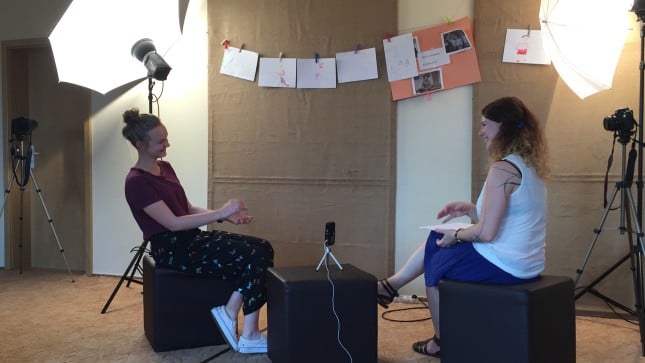
Laura, you are both a designer and a teacher, I would like to touch on both parts of your personality. Firstly, what do you want to achieve in the field of design?
PCU showed me what I could do in the field of design. My Master's thesis was something completely different from anything that I had ever done. I studied graphic design, and I always thought it would be what I was going to do, and I enjoyed it. But then I realised that it was not enough for me, and that there was much more to discover. At PCU
, we had an open topic for the development of our thesis, no limits were set except that it had to contain design innovation. On the one hand, I was quite lost at first, but on the other hand, it opened up completely new areas for me. It was because of my Master's thesis that I chose to work with children as I collaborated with my own group of child designers. And even though I had never entertained the thought of working with children, suddenly what I was doing made total sense to me.
What was your reasons for choosing Future Design and Prague City University after completing your Bachelor's degree in graphic design?
Honestly, it was such an experiment. I had a break after finishing my Bachelor's degree and my friend and I went to visit PCU because at that time we were interested in studying there, but they did not offer Master's degrees. Then, when I was in London for half a year, I learned that the Master's degree would open the following year. I had a few conversations with the programme leader Petr Knobloch, and he told me what the degree would actually entail. I considered it an interesting opportunity as we would start to form the beginning as the first students in this programme and would have his full support and guidance.
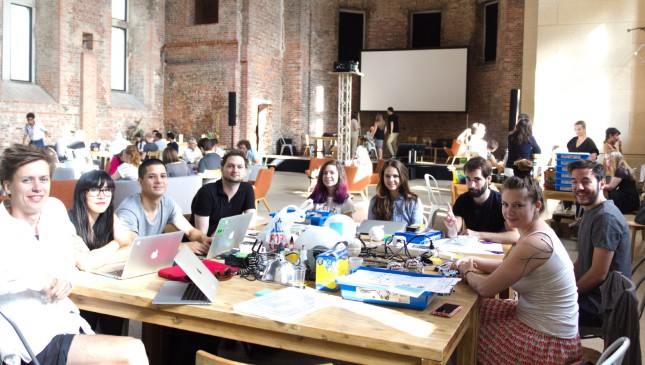
Prague City University prides itself on specializing in design thinking, openness and debate, while traditional schools focus more on efficiency. Can you compare Pilsen and PCU?
I've seen the difference from the beginning. Pilsen was a classic school, where we went through everything, which I was happy about. I am a person who likes to create with my hands, and I'm grateful to have gone through more disciplines, such as figure drawing and book creation. But as you say, it's mainly focused on the tools, at least the Bachelor's degree that I had experience with. Unlike Prague City University, where the first task was to create a new visual for the school, but in fact the project was not about the visual as such. In the beginning, we all started creating designs and sketches like we were used to, but Peter swept them off the table. He asked us what kind of school we were, the position of the school on the market, who are the people we are addressing. So we had to dive deep and first understand the product. It was the very first time I had done anything like this.
When you undertook tasks at both schools, was there a difference in the work you submitted?
In Pilsen, these were projects that were created and closed in a drawer, and we created them in the time that we were given to do them. There weren't that many projects at PCU. In two years, there was one small project at the beginning that opened our eyes to what "research" is. We also had an external lecturer Michael Büss teach us about speculative design mainly via online classes, which was challenging for me because it was very philosophical. Moreover, at that time I was just starting to study English.
So what was the assignment for your speculative design project?
The assignment was City Living and everyone went in completely different directions. At first I tried to think of the city and its inhabitants dancing. I thought of people, crowds and my passion for dancing, but it didn't lead anywhere. Then I started thinking of birds in the urban environment, what kind of birds are here and how they adapt to the environment, or do they come to the city only for a short while or choose to avoid the city completely. This created a project proposal, a social experiment based on research, and later I added visualizations of potential situations. The result is a Bird simulator, a helmet that you put on your head in the busy city and the sounds from the park (bird calls, the rustle of trees, etc.) are transmitted to your ears. But at the same time, because the speculative design is supposed to provoke, by turning on the simulator, the sound of the city traffic is transferred back into the park. This was a speculative design project that lasted one semester and complemented our main studio work.
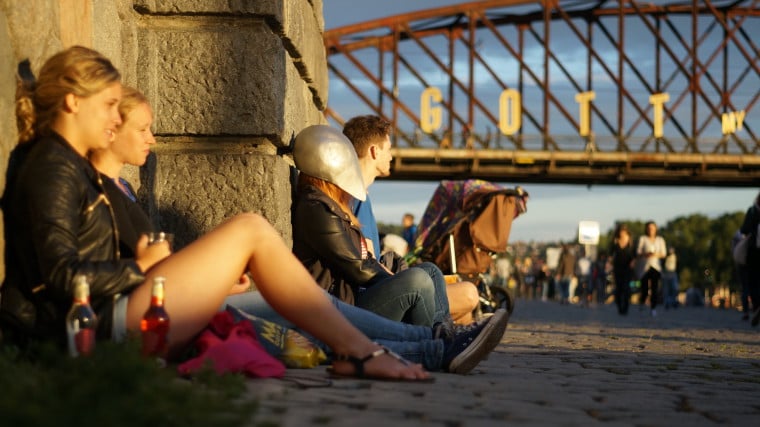
In the second semester of the first year, I began to touch on a topic, which was later addressed in my Master's project. I examined memories and emotions, and researched many ways of reading emotions and feelings, where the science is, if there are any systems that sense what is happening in the brain, if emotions are recognised, and in fact the output for this whole semester was "only" research on a topic that interests us.
There is also an emphasis on technology and innovation. What technologies or new practices did you work with?
We explored VR because our classmate used virtual reality. He had a studio at home, so we went to visit him on a field trip, and there we experimented with drawing in virtual reality and how it is used in design. We tried to design a car by "sitting in it" and then drew it around us without having to deal with the scale. It was certainly interesting to see how he uses VR in practice.
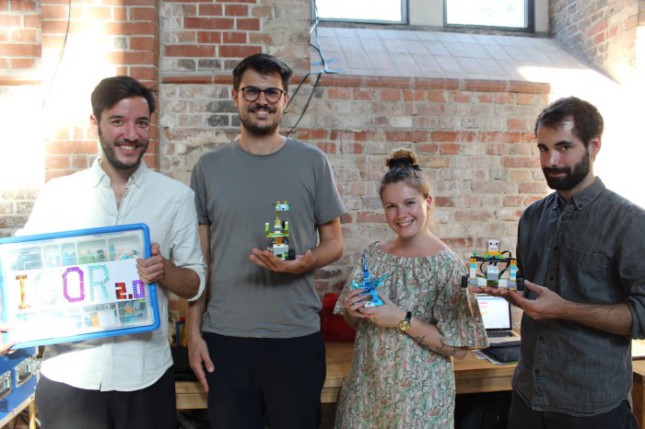
During the theoretical work, did you consider any newer technologies?
Yes. Peter always said, "Say no to fairy tales, yes to science fiction." It has to be a topic that is already being worked on, someone is working on it, and it's evolving. We talked about Elon Musk almost every hour, and in fact we always tried to find out what was new, how it could be used, and how it was developing.
Did you have any lectures for example on world trends, where science is heading or where technologies are heading, or did you solve this within the studio?
We dealt with it more in the studio, and we gave lectures to each other because everyone was working on their project, and everyone was investigating in different areas. We were an interesting group in the studio. We were quite diverse and everyone was doing something completely different. There was a girl who was interested in architecture, a classmate who was interested in production technology and VR. We sat in a circle and presented our weekly progress, and it was such a mini-lecture because we shared our findings on what was interesting and what was new in the world of technology.
Now to address your teaching career. Do you feel your experience as a student influences how you teach children now?
I work as a teacher's assistant, so I don't really teach and I can't make decisions and lead lessons. But where I definitely tried to implement my ideas was when I was working on the development of Montey. My dissertation, with four children - my co-designers, I wanted to guide the children, as my colleagues, through the design process from the beginning. I collaborated with four students from ZUŠ, the town where I come from. I went there every week for a joint session and introduced them to my project which aimed to create a robotic companion for children that would work on the principles of artificial intelligence.
First, I had to come up with a concept because I didn't really know what the kids wanted and needed. Should we design an object for the table, or should it be part of the watch they wear, or is a phone enough? I tried to keep our sessions very open, but it was clear how tight they are in the Czech school system. They were excited about my approach, and they liked that they could create Monty almost on their own and figure out what they really wanted.
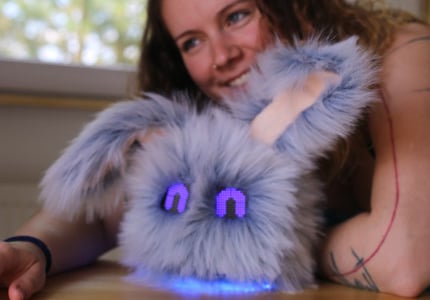
What did you finally choose as the central theme of this project?
The first questions were, what should Montey look like, should it be an object, or should it be part of something? And when will you interact with him? It was important to find out what bothers children the most, what their issues are, what they live by. The children are at school every day, they have friends there and they spend most of their time there. I asked if they wanted anyone to talk to them about school at all or not, and how their communication was with their parents when they spoke about school.
Have you come to the conclusion that the children solved these problems with something that they have created, rather than talking with their parents?
Yes. We did such an interesting experiment. We put together a conversation only with emojis, and they said that this was actually enough for them. This was preceded by an experiment where I tried the Wizard of Oz method. I corresponded (with the permission of parents) with several children via Montey's profile. First we sent each other pictures, and then I started writing. It was shocking to me that they didn't mind who was behind the profile. They confided in Montey, not knowing who was behind him. Thus came the name Montey and the idea of a companion project for children.
His task is to manage the school day in a certain way. In the morning, for example, he says, "You have a math test today, don't worry, you can do it, because you practiced yesterday." Or "You have sports, don't forget your shoes." so they are not alone. The children said that after school homework is a big problem. Parents do not have time to help. Kids prefer to play on the phone, they are prone to distraction. Montey is there to remind them of their tasks and motivate them to complete it.
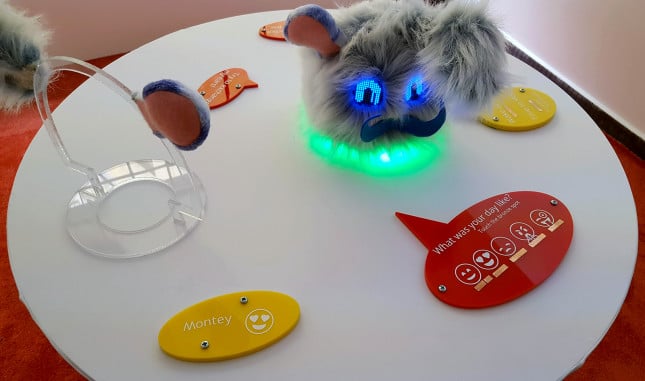
So does Montey work on the basis of artificial intelligence? Was it functional?
It was a prototype, not a fully functional product. The basic idea was, for example, to connect with the school's IT system. The child will communicate with a robot that has access to information, such as test results, so he will be able to say you got a number one today, so your average has improved, that's great.
How did you come up with the idea of a cuddly animal when it came to children between the ages of twelve and fifteen? What did the design process look like next?
They suggested it, we drew it, the idea that he should be hairy came from them too. We went through various design methods. Wizard of Oz, the interesting pros and cons, Mind Map and we workshop different scenarios. We also considered the situations where they would use Montey. What their moods were like during the day and when they would most need a companion. We analysed the target group and our debates revealed what Montey should do. He would help with school, motivate with tasks and show the positives.
Then we solved the form and from the very beginning the idea arose that it would be a home robot with some intelligence. Hairy, big ears, eyes, that liked to change clothing, so Montey has replacement ears, accessories and clothes. I touched on Arduino programming, which was something completely new for me. Then Montey's skeleton was printed, a friend sewed his costumes, and the prototype was coded with five interchangeable pairs of eyes.
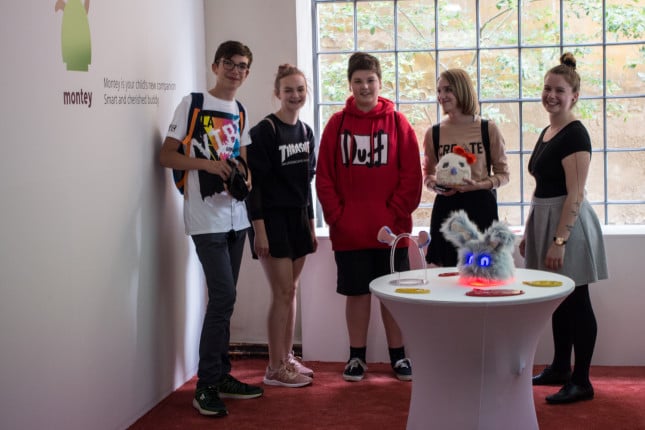
The final output for my diploma thesis was, in addition to the prototype of Montey, two videos. The first was a presentation, actually an advertisement for Montey. These were examples of interactions between Montey and the children in their daily lives. The children interacted with him in the video and I mechanically controlled and spoke for Montey.
The second video was a documentary where I explained the whole process and it also includes interviews with the children - the co-creators. I'm proud of that documentary, because it worked so well. It showed that the children enjoyed the process and even said that they did not believe that the project would go as far as it did and that they really wanted their own Montey. My friend worked on the film, so he helped me with the shooting, which was also an experience for the children. Especially for one guy who is a YouTuber.
The final presentation of the work was also very successful. In Pilsen I was given space, and in cooperation with students from the Fine Art studio, we solved the overall concept of the exhibition and the spatial solution ourselves. I divided the area for my presentation with a wall. In one part, I created a shop where Montey was sitting and people could try it out and watch the advertising video. In the next area, a mini-cinema was created, where a documentary about the process of Montey's production was screened.
Are you planning to implement Montey, so connect with someone who can create artificial intelligence and set the project in motion?
I would like to, but it's technically and financially very demanding, actually it's impossible for individuals. But as part of the work on the project, I was in contact with the Czech branch of IBM and I was pleased with their interest and helpful response. I'm currently playing with TJ Bot, which is a robot from IBM that I think could help Montey at least in the beginning and add some skills to him.
Where do you see yourself in the future?
Now I work with children, catching up on teaching experience. I liked that during my thesis I was able to connect design and work with children. In the future, I would like to run design courses for children. At the school where I work, we have a class - robotics, and we are going to a competitive tournament for the first time. Even in these circles, I try to push design and conceptual thinking. I want children to think about how they could change their daily lives for the better, even in small ways, and how to use technologies that are so enmeshed within them and their generation.










